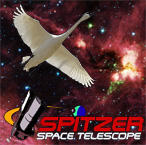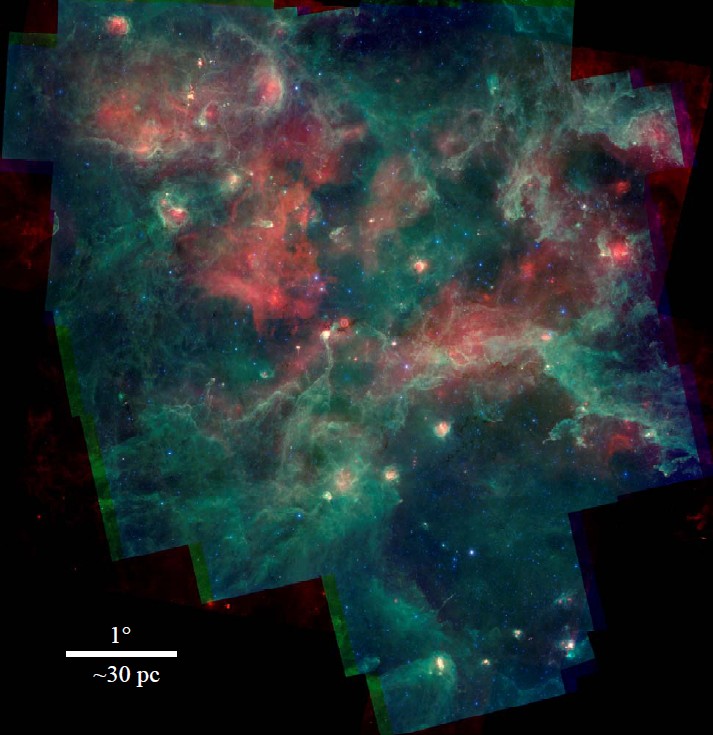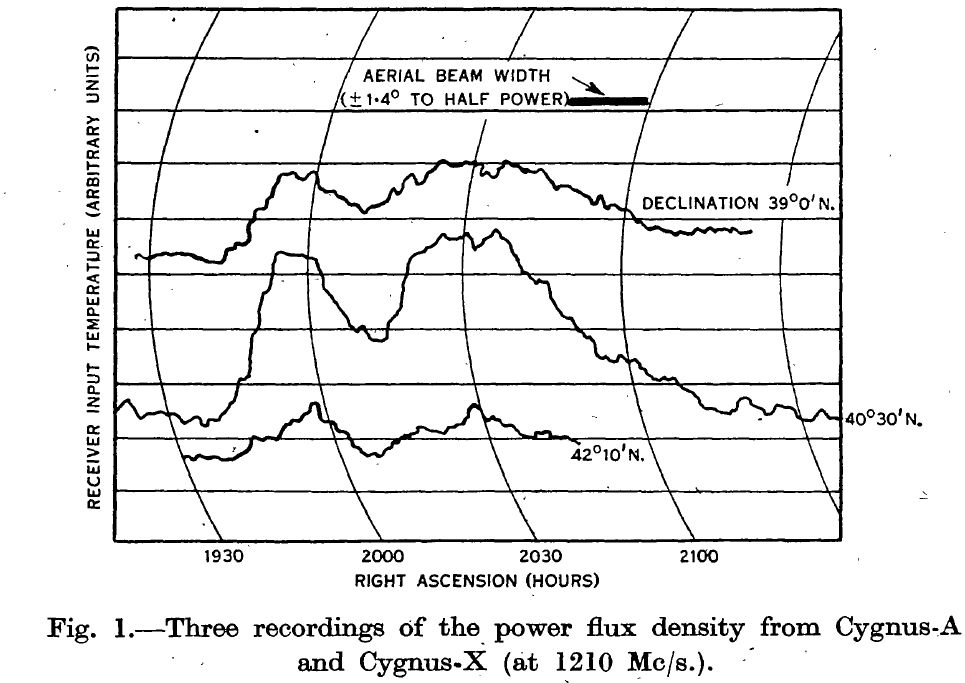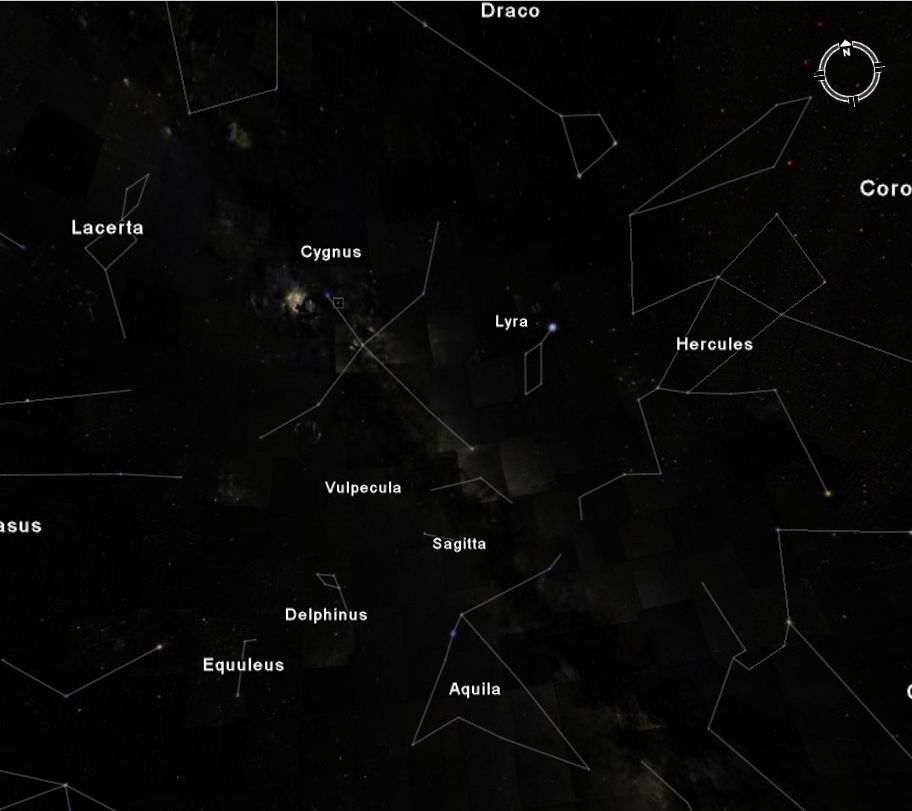 |
 |
- Cygnus-X Home
- About
- What is?
- Data
- News
- Publications
- People
| What is Cygnus-X? | ||||
|
The name "Cygnus-X" was first assigned to the diffuse radio source in the constellation Cygnus by J. H. Piddington and H. C. Minnett (1952, AuSRA, 5, 17; see figure below) to distinguish it from the other well-known radio source in Cygnus, the powerful radio galaxy Cygnus-A. They identified the emission in Cygnus-X as being from clouds of ionized interstellar gas. Cygnus-X is one of the richest known regions of star formation in the Galaxy. It contains as many as 800 distinct H II regions, a number of Wolf-Rayet and O3 stars and several OB associations. The association near the center of the complex, Cygnus OB2, was known to be large from optical observations (Reddish et al 1966, Massey & Thompson 1991). Subsequent IR observations indicated that Cygnus OB2 contains as many as 2600±400 OB stars and ~100 O-stars, with a total stellar mass that could be as high as 105 Msolar (Knödlseder 2000, Comerón et al. 2002; Hanson et al. 2003). Cygnus-X also contains one of the most massive molecular complexes of the nearby Galaxy with a total mass of 3x106 Msolar (Schneider et al. 2006). Cygnus-X has been long argued to be the superposition of a number of star-forming regions (Dickel et al. 1969). However, a detailed comparison of 13CO 2 to 1 and 1 to 0 emission with MSX images led Schneider et al. (2006, 2007) to conclude that the molecular clouds in Cygnus-X form connected groups, and that the Cyg OB2 and OB1/OB9 associations directly heat the molecular material in Cygnus-X.
The implication is that the majority of objects seen in this region are located at the same distance, i.e., that of the OB2, OB1 and OB9 associations at ~1.4 kpc. This includes sources like DR21 and S106, formerly estimated at 3 kpc and 600 pc, respectively, and implies that Cygnus-X is largely composed of a single 200 pc diameter, 3x106 Msolar complex. Thus, it has 3x the combined mass of the molecular clouds within 500 pc of the Sun, in a region 1/5 the diameter. Given the high rate of high-mass star formation in Cygnus-X, as demonstrated by the existence of 40 massive protostars in regions such as DR21, DR21(OH), and W75N, Cygnus-X is thus the most active, rich, and massive star-forming complex within 2 kpc from the Sun. In addition, the close association of a rich OB cluster such as OB2 with a massive molecular complex is exceptional. We are probably witnessing an OB association that is growing while still embedded in its molecular complex. The mass is much larger than other nearby molecular clouds with OB associationssuch as Orion A (105 Msolar; Bally et al. 1987), M17 (3x105 Msolar; Elmegreen et al. 1979) or Carina (2x105 Msolar: Schneider & Brooks 2004). Consequently, Cygnus-X appears to be giving birth to the largest OB association within 2 kpc. Where is Cygnus-X? The survey region is a ~5x5 degree box roughly centered at 20h31m, +40d20s, located in the constellation Cygnus. This is right in the "heart" of the swan, and includes Gamma Cygni (Sadr), the center star of the "Northern Cross". It includes several OB associations, including Cygnus OB2, and the "Cygnus Rift", a dark lane of interstellar matter that obscures the stars in our Galaxy behind it. The star forming associations we are studying are located at a distance of about 1.4 kpc, or 4500 light years from Earth. The image below shows how Alexander Jamieson depicted Cygnus in his stellar atlas of 1822. Below is an all-sky image from the MMT Observatory on Mt. Hopkins, AZ. In October, the Galactic plane is nearly overhead in the early evening from the northern hemisphere. The green box is the rough location and size of the survey region. The main stars of Cygnus are visible, and the Galactic plane cuts across the sky from the SW to the NE, with the Galactic Center at the SW edge. The MMT telescope enclosure building is visible at the right edge of the image.
Cygnus constellation, from Google Earth
| ||||





